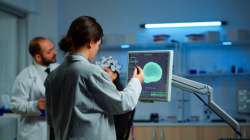Brain's adaptability in blind individuals recognising faces through sound: Study
The study highlights the brain's remarkable adaptability in blind individuals, showcasing its ability to recognise faces through alternative sensory channels and contributing valuable insights into neuroplasticity and sensory compensation.

Scientists at Georgetown University, US, have identified the brain region responsible for blind individuals recognising basic faces using a sensory substitution device. The study, published in the journal PLoS ONE, delves into the compensatory mechanisms blind people employ to recognise visual patterns through auditory stimuli. Josef Rauschecker, a professor in the Department of Neuroscience at Georgetown University, explained that the study tested the plasticity between seeing and hearing by encoding visual patterns into auditory ones using a sensory substitution device. The device translated images into sounds, enabling blind participants to recognize basic facial configurations like a 'cartoon' face emoji.
Functional magnetic resonance imaging (fMRI) was employed to pinpoint the brain area involved in this compensatory plasticity. The results indicated that the development of the brain's fusiform face area did not rely on visual face experience but rather on exposure to the geometry of facial configurations, which can be conveyed through other sensory modalities.
Paula Plaza, one of the lead authors and currently affiliated with Universidad Andres Bello, Chile, emphasised that the fusiform face area encodes the 'concept' of a face regardless of the input channel or visual experience, marking a significant discovery.
The study involved six blind and ten sighted individuals who underwent practice sessions to learn face recognition through sounds. Initially trained to recognize simple geometrical shapes, such as lines, the participants progressed to more complex stimuli, including houses and faces with varying features.
Through fMRI scans, the researchers observed that in blind individuals, the sounds activated the left fusiform face area for facial recognition, while in sighted individuals, facial recognition occurred predominantly in the right fusiform face area.
Rauschecker noted that the left/right difference observed in blind and sighted individuals might offer insights into how each side of the fusiform area processes faces, either as connected patterns or separate parts. This understanding could aid in refining sensory substitution devices designed for the visually impaired.
Also read | SpaceX Starship rocket explodes eight minutes after launch